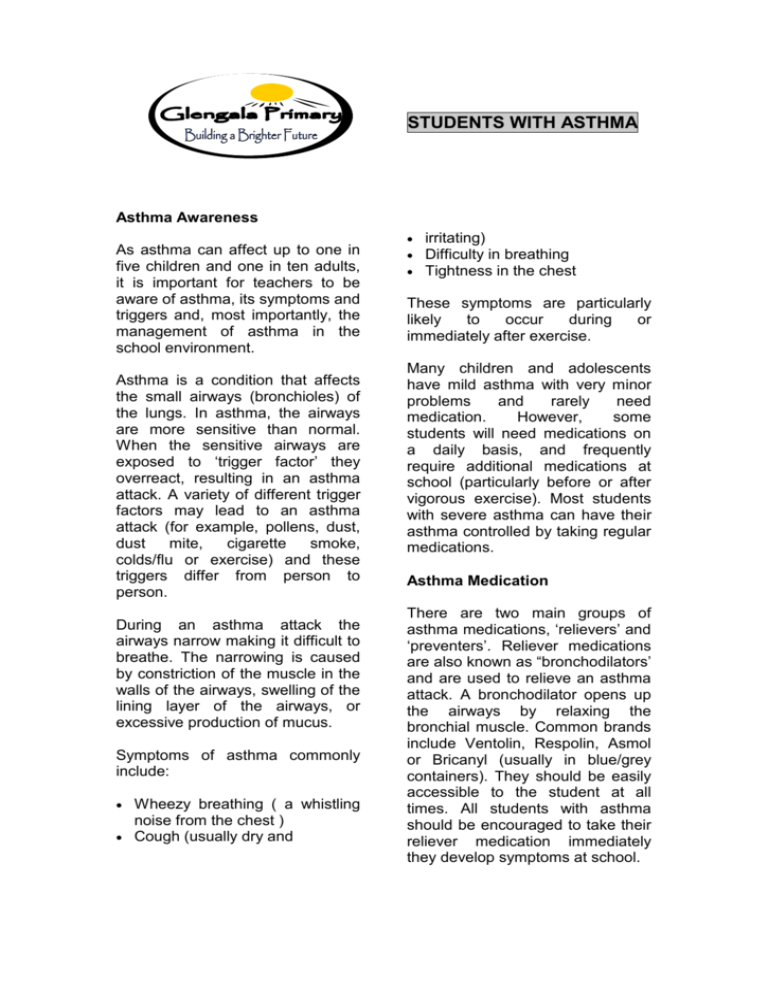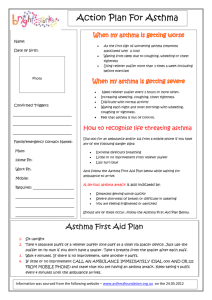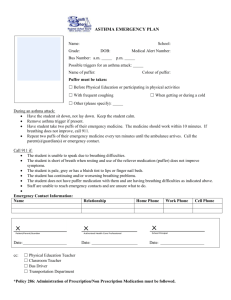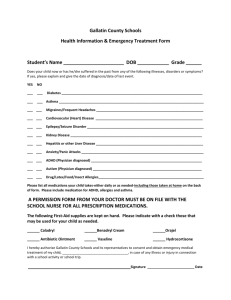STUDENTS WITH ASTHMA - Glengala Primary School
advertisement

STUDENTS WITH ASTHMA Asthma Awareness As asthma can affect up to one in five children and one in ten adults, it is important for teachers to be aware of asthma, its symptoms and triggers and, most importantly, the management of asthma in the school environment. Asthma is a condition that affects the small airways (bronchioles) of the lungs. In asthma, the airways are more sensitive than normal. When the sensitive airways are exposed to ‘trigger factor’ they overreact, resulting in an asthma attack. A variety of different trigger factors may lead to an asthma attack (for example, pollens, dust, dust mite, cigarette smoke, colds/flu or exercise) and these triggers differ from person to person. During an asthma attack the airways narrow making it difficult to breathe. The narrowing is caused by constriction of the muscle in the walls of the airways, swelling of the lining layer of the airways, or excessive production of mucus. Symptoms of asthma commonly include: Wheezy breathing ( a whistling noise from the chest ) Cough (usually dry and irritating) Difficulty in breathing Tightness in the chest These symptoms are particularly likely to occur during or immediately after exercise. Many children and adolescents have mild asthma with very minor problems and rarely need medication. However, some students will need medications on a daily basis, and frequently require additional medications at school (particularly before or after vigorous exercise). Most students with severe asthma can have their asthma controlled by taking regular medications. Asthma Medication There are two main groups of asthma medications, ‘relievers’ and ‘preventers’. Reliever medications are also known as “bronchodilators’ and are used to relieve an asthma attack. A bronchodilator opens up the airways by relaxing the bronchial muscle. Common brands include Ventolin, Respolin, Asmol or Bricanyl (usually in blue/grey containers). They should be easily accessible to the student at all times. All students with asthma should be encouraged to take their reliever medication immediately they develop symptoms at school. Students with moderate to severe asthma may also be required to take medication that helps prevent their asthma (a ‘preventer’). Preventer medications help reduce and prevent the inflammation in the lining of the airway. Common preventers include Intal, Intal Forte and Tilade (usually in white or yellow container) or inhaled cortiosteriods such as Becotide, Becloforte, Pulmicort or Aldecin (usually in brown/yellow/beige containers). These medications need to be taken twice daily (morning and evening) and therefore will often be taken in the student’s home. Intal, Intal Forte or Tilade are also used in the management of exercise-induced asthma. Preventer medications do not relieve an asthma attack. Students with asthma should always carry, or have available in the school, appropriate medication. Parents/Guardians are responsible for ensuring that their children have an adequate supply of the appropriate medication at school. a Volumatic for Ventolin, Asmol, a Nebuhaler for Bricanyl) in the school’s first aide kit. In some instances, students may have their medications administered via a nebukliser pump if their asthma is very severe, or their doctor and parents/guardians feel that this is the most effective means of delivering the medication. Parents/Guardians may wish to provide a nebuliser pump at school for their child’s use. If that is the normal recommended delivery method required by their treating doctor, it may be done so when the: Asthma Devices Medication Delivery Asthma medications are generally taken via a hand-held inhaler device such as a ‘puffer’ (metered dose inhaler) or dry powder inhaler (turbuhaler, spinhaler or rotahaler). It is recommended that a puffer be used in conjunction with a ‘spacer’ to assist with fast and more effective delivery of the reliever medication. Note: Schools should provide a bronchodilator metered dose inhaler (for example, Ventolin, Respolin, Asmol or Bricanyl ‘puffer) and a spacer device (for example, Parents/guardians negotiate with the principal and at least two staff members for the use of a nebuliser pump at school for their child and the staff are prepared to learn how to use the pump. Treating doctor verifies that the medication can only be delivered effectively through a nebuliser. Parents/guardian ensures that the pump is serviced regularly. Students have their own nebuliser mask, bowl and tubing and the parent/guardian provides new equipment as required. Student wherever possible is responsible for cleaning their own nebuliser mask and bowl. Parent/guardian provides the medication that is labelled with the name of the drug, the dosage, frequency of use and the child’s name. Treating doctor provides a signed and dated asthma medication plan with the medication, dosage, frequency and method of use. Plan is countersigned by the parents/guardians and updated as needed. Medication is stored in the school’s sick room (some medications may be required to be kept in the refrigerator). Nominated staff regularly check the expiry dates on the medications. Parents/guardians are responsible for replacing the medication as needed. Asthma Management Plan Every student with asthma attending the school should have a written asthma management plan filled out by their family doctor or paediatrician, in consultation with the student’s parent/guardian. This should be attached to the student’s records. The management plan will include: Cleaning of Delivery Devices Devices (for example, puffers, spacers) that are used by more than one person must be cleaned thoroughly after each use to prevent cross infection. Devices can be easily cleaned by soaking in Milton’s solution (used to sterilise babies’ bottles) or an equivalent hypochlorite solution. The steps for cleaning devices are: Ensure the canister is removed from the puffer container (the canister must not be submerged) and the spacer is separated into two parts. Wash devices in hot soapy water and rinse well. Make up a 1:20 solution of Milton’s or equivalent (dilute the antiseptic to 1 in 20 with water) and soak devices in this for twenty minutes. Rinse well and allow devices to ‘air dry.’ Do not wipe dry. Discard solution after use. When completely dry, ensure canister is replaced into puffer container and check the device is working correctly by giving one or two ;puffs’ into the air (or against a mirror). A mist should be visible upon firing. Usual medical treatment (medication taken on a regular basis when the student is ‘well’ or as premedication prior to exercise. A written action plan detailing medications to be used in cases of deteriorating asthma. This should include how to recognise worsening symptoms and what to do during an acute attack. This action plan will be provided by the student’s doctor and should be easily accessible to all staff. Name, address and telephone number of an emergency contact. Name, address and telephone number (including an after-hours number) of the student’s doctor. Supplementary First-Aid Supplies As well as ready access to the details of each student’s asthma (usual treatment and action plan) it is essential to have equipment for managing an asthma attack available in every school’s first aid kit. This must include: A bronchodilator metered-dose inhaler (for example, Ventolin, Asmol or Bricanyl puffer). A large volume spacer device to assist with effective inhalation of the bronchodilator, for example, a Volumatic for Ventolin, a Nebuhaler for Bricanyl (in some instances, students may use low volume spacers via a facemask, for example, Aerochamber or Breath-a-Tech with mask(s)). Clear, written instructions on how to use these medications and devices, plus the steps to be taken in treating an acute asthma attack as described below. Schools can legally obtain a bronchodilator metered-dose inhaler for first-aid purposes from a pharmacist on written authority of the principal. Exercise-induced asthma (EIA) can frequently be prevented by a simple warm-up period and medication immediately before the exercise (premedicate with two puffs of either a bronchodilator Reliever) or Intal or Tilade (preventers often used is the management of EIA) or both as recommended by the student’s doctor). Obtaining better overall control of the student’s asthma with long-term preventive treatment (for example, Intal, Intal Forte or inhaled corticosteriods) also reduces the likelihood of exerciseinduced asthma. Treatment A staff member needs to be delegated the responsibility of regularly checking the expiry date on the bronchodilator metereddose inhaler. Exercise Induced Asthma All students with asthma should be encouraged to exercise regularly to improve cardiovascular fitness and general well being. However, exercise (particularly strenuous exercise) can bring on an attack of asthma in about 85 percent of children with asthma. Exerciseinduced asthma may vary considerably from day to day and can be particularly troublesome when the student has a cold or flu, or is recovering from a recent flareup of asthma or during very cold weather. In many instances, the difficulty in breathing comes on soon after completion of the exercise when the student is ‘cooling down’ rather than during the exercise. Prevention If students develop exerciseinduced asthma, they should immediately cease the exercise, rest and take a bronchodilator (reliever) using a metered-dose aerosol inhaler (preferably with a spacer device). Once all symptoms disappear they may be able to resume their exercise program. However, if the symptoms persist or worsen the attack needs to be managed as outlined below. Emergency Treatment Asthma Attack of an If a student develops signs of what appears to be an asthma attack, appropriate care must be given immediately. Mild: This involves coughing, a soft wheeze, minor difficulty in breathing and no difficulty in speaking in sentences. Moderate: This involves a persistent cough, loud wheeze, obvious difficulty in breathing and able to speak in short sentences only. Severe: The student is often very distressed an anxious, gasping for breath, unable to speak more than a few words in one breath, pale and sweaty and may have blue lips. All students judged to be having a severe attack require emergency medical assistance. Call an ambulance and carry out the steps listed while waiting for an ambulance to arrive. Regardless of whether an attack of asthma has been assessed as mild, moderate or severe, treatment must commence immediately. The danger in any acute asthma situation is delay. Delay may increase the severity of the attack and ultimately risks the student’s life. Treating an Asthma Attack If the student has an action plan follow the steps immediately. If no action plan is available, the steps outlined should be taken immediately. These steps should be clearly displayed in the staff room so that all staff is well versed with them. They should also be written on a card in the first-aid kit. The steps are: If the student’s own bronchodilator puffer is not readily available, a bronchodilator puffer should be obtained form the first-aid kit, or borrowed from another student or teacher, and given without delay. It does not matter if a different brand of bronchodilator is used. Sit the student down (as breathing is easier sitting rather than lying down) and provide reassurance. Remaining calm will also assist in reassuring the student. Without delay administer another four puffs of bronchodilator via a spacer noting the following instructions: Shake the asthma puffer; insert it into the spacer and fire two puffs in rapid succession into the spacer chamber. Ask the student to breathe in and out through the mouthpiece for four breaths (the student does not need to take their mouth away for each breath out as the mouthpiece contains a one way valve). Repeat immediately to administer two further puffs. Wait four minutes. If there is no improvement, repeat step 2 (third dot point above). If there is still no improvement, an ambulance should be called immediately (dial 000). State clearly that a student is having an asthma attack. The ambulance service will always give priority to an asthma attack. Repeat steps 2 and 3 (third and fourth dot point above) continuously while waiting for an ambulance to arrive. Contact the student’s parents/guardians and doctor immediately. Even if the student has a complete recovery from the asthma attack, their parents/guardians or doctor should be notified of the incident. If no spacer device is available: Shake the puffer. Have the student hold the puffer either in the mouth, or slightly away from the open mouth. Either the student, or the staff member, should fire the puffer the moment the student begins to take a slow steady breath in (inhalation/inspiration). Ideally, the student should hold their breath for four seconds at full inspiration. Allow the student to take four normal breaths of air, then repeat the above procedure until four puffs of bronchodilator have been delivered. Wait four minutes, if there is no improvement, repeat the above steps. If there is still no improvement, call an ambulance immediately. Repeat the above steps continuously while waiting for the ambulance to arrive. If at any time the student’s condition suddenly worsens, call an ambulance immediately. Bronchodilator metered-dose aerosol puffers are quite safe. An overdose cannot be given by following the instructions outlined. However, it is important to note that the student may experience side effects of shakiness, tremor, or a racing heart. If no spacer device is available and the student is unable to coordinate using a puffer, an improvised spacer device can be used, for example, have someone cup their hands around the student’s nose and mouth and have a second person ‘fire’ the puffer into the cupped hands, or put a hole in the bottom of a polystyrene cup, place the cup over the student’s mouth and ‘fire’ the puffer through the hole. What if it is the First Attack of Asthma? A problem that may be encountered is when a student suddenly collapses at school, or appears to have difficulty breathing and is not known to have preexisting asthma or other health problems. In this situation, an ambulance should be called immediately and four puffs of a bronchodilator should be administered while waiting for the ambulance to arrive. If the student’s breathing appears to improve with the bronchodilator, this should be repeated as outlined in the emergency treatment. This treatment could be life saving for a student whose asthma has not been previously recognised, and it will not be harmful if the collapse was not due to asthma. Bronchodilator puffers are extremely safe, even if the student does not have asthma. The Asthma Foundation of Victoria provides education and resources for teachers (including a teacher inservice kit) and students. The Asthma Foundation of Victoria can be telephoned on 9853-5666 or 1800 645 130 (country callers).







